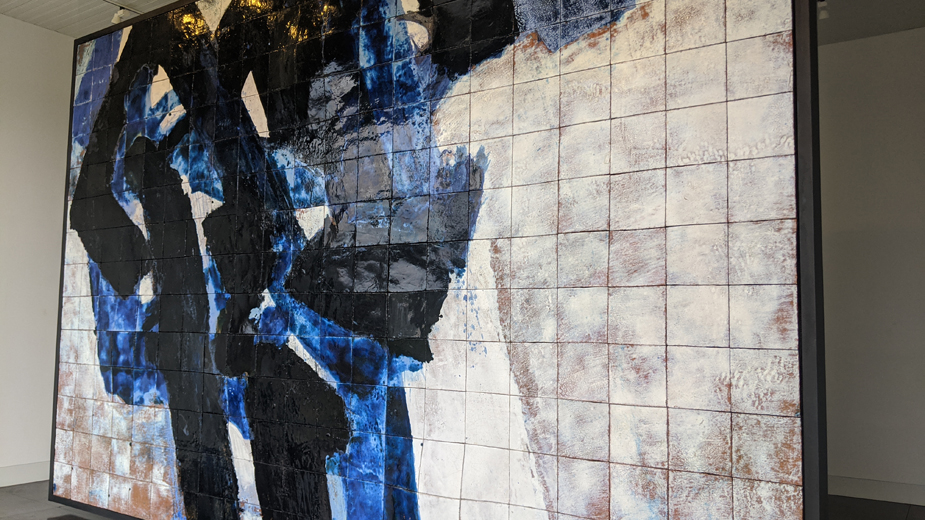YOUNGSTOWN, Ohio – The split between Foundation Medici and the Butler Institute of American Art has come down to one massive abstract mural.
The untitled 14-by 20-foot ceramic tile piece by French artist Pierre Soulages remains on display at the Medici Museum of Art in Howland, in the gallery that has been its home since The Butler acquired it in 2009.
Both sides assert that they are the owner and the decision now rests with the courts.
The Butler no longer operates the location that once was its Trumbull branch. Last year Foundation Medici, which owns the building, severed its contract with The Butler in a well-publicized split and started its own museum there.
Now, The Butler wants to remove the Soulages piece – as it already has done for all of its other art once displayed there – and bring it back to its Youngstown museum. But The Medici claims it is the owner and filed suit to retain possession.
In a ruling last month, Trumbull County Common Pleas Judge Andrew Logan ruled that the Soulages mural belongs to The Butler. Foundation Medici is appealing that ruling.
As the two entities battle it out in court, it’s interesting to note why this piece of art, created in 1969, is so desired by both parties. For one thing, it’s appraised at $650,000 and is likely worth more. For another, its creator, who is 100 years old, is considered France’s greatest living artist.
The mural and its gallery are a physical hallmark of the Medici museum building: a gallery with a large window was built there, paid for from donations solicited by The Butler, to house the artwork in a way that makes it visible to passing motorists. The $366,000 project included $250,000 to construct the gallery and another $98,000 to restore the mural.
In its lawsuit, The Medici asserted that the mural has become a permanent “fixture” of its museum – meaning that it has legally become part of the realty.
Judge Logan disagreed, writing in his ruling that the mural could be removed without damaging the building and its gallery could be used for other works of art.
Medici also argued its possession of the mural is a charitable trust. Judge Logan rejected that claim.
The Soulages mural, by the way, is composed of 300 tiles, each 11 inches by 11 inches and weighing 10 pounds. The artist painted upon this unique “canvas” as though it were one solid piece.
I remember the day that Louis A. Zona, director of The Butler, acquired the Soulages mural.
Zona, of course, has great knowledge and appreciation of art and can get excited when his museum acquires a piece that he admires and has long sought. But his excitement for the Soulages reached a level that I had seen only two other times: when the Butler acquired paintings by Norman Rockwell (2007) and Jackson Pollock (2009).
I wrote a story back then about The Butler’s acquisition of the Soulages that sheds a lot of light on how Zona rescued it. I refer to that Oct. 18, 2009, story in The Vindicator below:
The Soulages mural had been on display in the lobby of 1 Oliver Plaza, a skyscraper in downtown Pittsburgh for 40-some years.
It had been commissioned as part of the building’s construction, but its respect had been diminished over the years. A security guard desk was placed in front of it, and at times it was partially obscured by planters.
The building was sold [in 2009] and the new owners decided the mural would no longer be part of its décor.
They offered it to the Butler – Zona had (previously) expressed interest in it – free of charge.
Zona, in fact, used to visit the Oliver Building when he was a graduate student at the University of Pittsburgh, long before he started his career at the Butler, just to admire the work. A few years before the sale of the building, he approached its owners to see if The Butler could purchase the mural but was told it was not for sale. After the Butler acquired the mural, Zona wrote the then-90-year-old Soulages in France to tell him his work will be moving to a new home in Ohio, where it will enjoy greater visibility.
Soulages wrote back to Zona, stating that he was overjoyed that his work was saved.
“Soulages,” Zona told me for my article, “is a living legend.” The artist’s works, by the way, also hang in The Louvre in Paris – a very rare honor for a contemporary artist.
Pictured: The ceramic tile piece is appraised at $650,000, and likely worth more.
